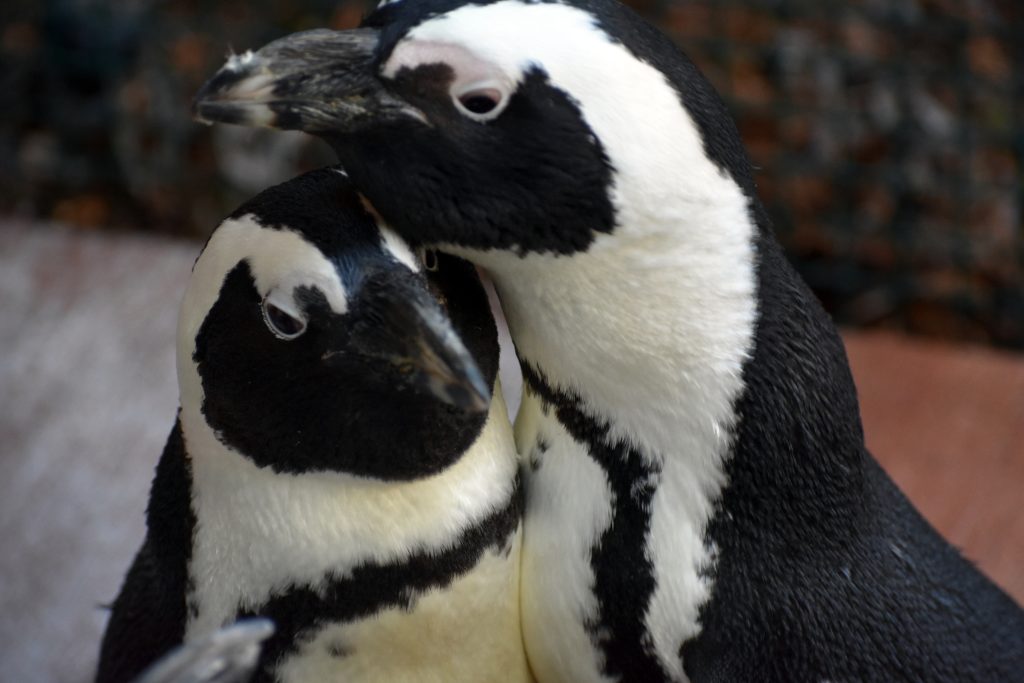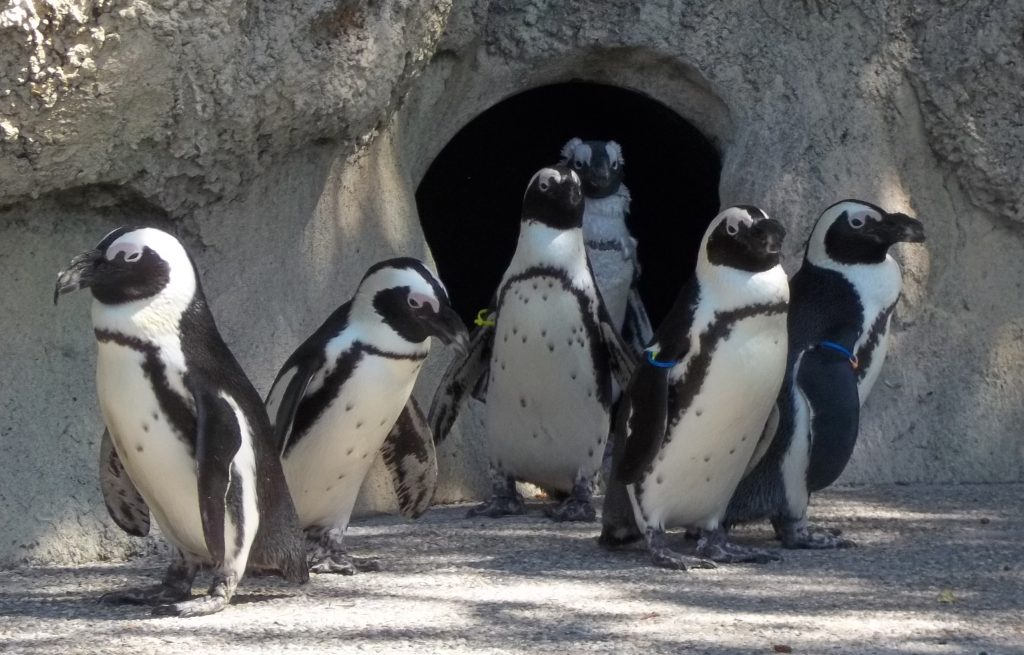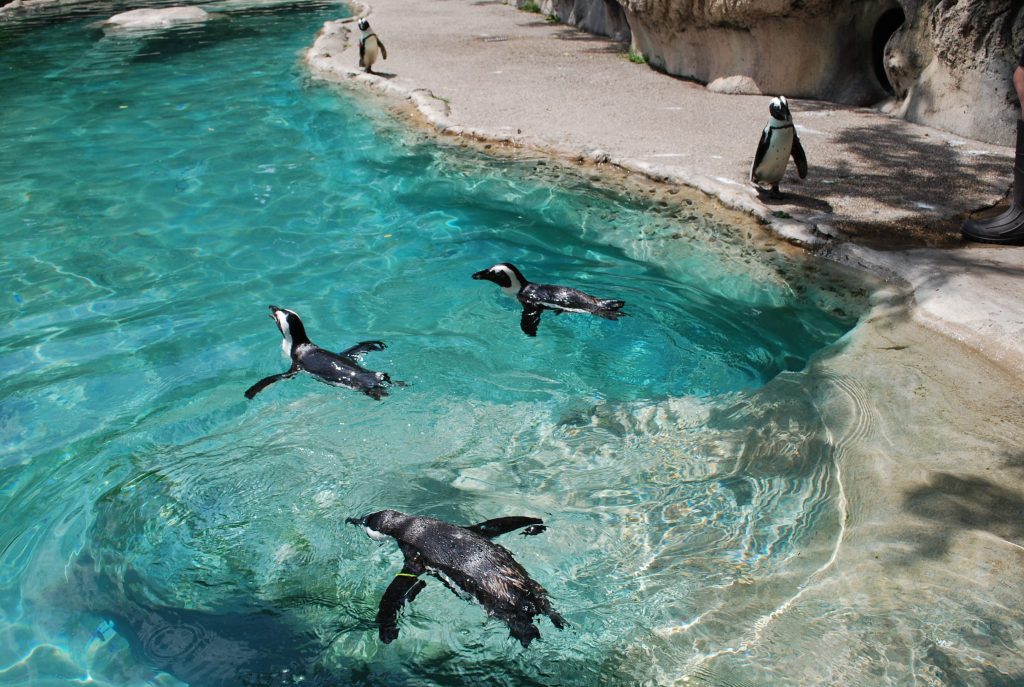Spheniscus demersus | African penguin, black-footed penguin, Cape penguin, South African penguin
Names:
- Male: Chilly, Robben, Bamm-Bamm, Blake, Jakada, Farley, Eggs Benedict, Quiche
- Female: Willy, Dewey, Petey, Ms Pac, Melody, Gobbles, Zebib



Meet Our Waddling Wonders: The African Penguin Flock
What’s black, white, and full of charm? Our African Penguins, of course!
With names like Zebib, Farley, Petey, Chilly, Bamm-Bamm, Willy, Blake, Ms. Pac, Gobbles, Robben, Dewey, Melody, Jakada, and our newest chicks—Eggs Benedict (Benny) and Quiche—this charismatic colony brings a whole lot of personality to our Zoo.
Benny and Quiche, born just before Christmas 2024, are the proud offspring of first-time parents Blake and Melody—a pair chosen through the African Penguin Species Survival Plan (SSP) to help protect and preserve this endangered species for generations to come.
Life in the Penguin Lane
Don’t let the tuxedos fool you—African Penguins are anything but formal. These flightless seabirds are fast, agile swimmers that can reach 12 mph underwater, hold their breath for two minutes, and dive up to 400 feet deep while hunting!
Their coloration helps them stay safe in the water using a clever trick called countershading
- Dark backs blend in with the ocean depths when seen from above.
- Light bellies match the sky when seen from below.
It’s like nature’s own camouflage suit.
On Land, They’re Loud, Loving, and Nest-Obsessed
When they’re not in the water, African Penguins come ashore to nest, raise chicks, and molt. You might spot our penguins collecting their favorite enrichment—nesting materials—as they prepare cozy homes.
Some facts about African penguin nesting:
- African penguins come together to nest and raise chicks in groups called a rookery
- Once a breeding pair has found a rookery, they will return to the same group every year.
- African penguins are monogamous, which means that they form lifelong pair bonds with their breeding partner.
- They communicate with loud, raspy calls that sound like braying donkeys
- Mating pairs bob heads and shake to strengthen their bond.
Every year, African penguins go through a catastrophic molt where they shed all their old feathers—making them look a little scruffy, but it’s totally normal! Before molting, they bulk up on food since they won’t be able to hunt again until their new waterproof feathers grow in.
What’s for Dinner?
In the wild, African Penguins feed on small schooling fish, like sardines and anchovies, as well as other animals like squid. At the Zoo, our penguins enjoy green-listed sustainable seafood like capelin, sardines, and lake smelt—carefully selected to mirror their wild diet while supporting healthy ocean ecosystems.
Fact Sheet
Taxonomy
Genus: Spheniscus | Species: demersus |
Kingdom: Animalia | Phylum: Chordata | Class: Aves | Order: Sphenisciformes | Family: Spheniscidae |
Favorite Enrichment Type
Anything that can be used as nesting material!
Diet
- In the Wild: Squid, and small schooling fish, like sardines and anchovies.
- At the Zoo: Green-listed sustainable fish that may include capelin, sardines, and lake smelt.
Life Span
- In the Wild: 10-25 years
- In Human Care: Up to 30 years
Geographic Range
Limited to the rocky coastline of southwest Africa, from Namibia to South Africa.
Habitat
Rocky coastlines and islands.
Status: Critically Endangered
A Crisis on the Coast
Conservation Status: Critically Endangered (as of July 2024)
African Penguins are in serious trouble. Once plentiful across the coastlines of Namibia and South Africa, their numbers have plummeted due to:
- Overfishing of their food sources
- Climate change is disrupting fish availability
- Habitat loss and oil spills
In fact, scientists estimate that if current trends continue, over 80% of the population could disappear in just three generations.
What We’re Doing
The Saginaw Children’s Zoo is proud to participate in several efforts to protect this incredible species:
- Species Survival Plan (SSP) – Ensures healthy, genetically diverse penguin populations in human care
- African Penguin SAFE (Saving Animals From Extinction) – Unites AZA zoos with global conservation efforts
- Support for SANCCOB – A frontline organization in South Africa that rescues and rehabilitates coastal birds affected by habitat loss, pollution, and injury
Every chick hatched at our Zoo represents hope for the future—and we’re proud to be a part of that legacy.
What Can You Do to Help?
- Choose Sustainable Seafood – Visit Seafood Watch to support responsible fishing practices
- Reduce, Reuse, Recycle – Cut down on single-use plastics that pollute oceans and coastlines by:
- Reducing the amount of single use plastic that you consume
- Reuse or repurpose items as much as possible
- Recycle items whenever possible, and purchase items/packaging that you know can be recycled in your area
- Lower Your Carbon Footprint –
- Use LED lightbulbs
- Walk, bike, or carpool
- Wash laundry in cold water
- Support clean energy initiatives
Want to know what Michigan is doing to help reduce our carbon footprint? Check out what Michigan’s Department of Environment, Great Lakes, and Energy (EGLE) is doing to reach carbon neutrality by 2050!
Even the smallest actions can make the biggest impact. Together, we can ensure that penguins like Benny, Quiche, and their flock continue to waddle into the future.
How to Find Us
Our penguin habitat is located just beyond the Covered Bridge, across from the North American river otter habitat and next to our aviary near the Wobbly Bridge! If it’s a warm enough day, come visit our Penguin Keeper chats, held at the Penguin Habitat at 11:30am and 3:30pm! African Penguin chats are dependent on weather. Please check our activity board, behind the Admissions booth, before coming to see us!
